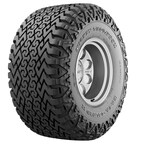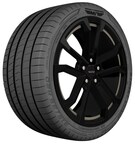AKRON, Ohio, Oct. 10, 2014 /PRNewswire/ -- Fading is the heat of summer, replaced by cool nights and mornings. Eventually, many areas of the country will be faced with consistently chilly, even sub-freezing temperatures.

This time of year serves as a reminder that a drop in tire inflation pressures corresponds with the falling thermometer readings. Goodyear (NASDAQ: GT) experts explain that air pressure in a tire typically goes down 1-2 pounds for every 10 degrees of temperature change.
"Odds are that many motorists haven't checked their tire pressure since the weather began turning cooler. If the last time the tire pressure was checked was during the heat of summer, many people could soon be riding on severely underinflated tires," said Steve Rohweder, Goodyear director of consumer tire technology.
Maintaining proper air pressure is the single most important thing drivers can do for their tires. Underinflation is a tire's worst enemy, as it causes increased treadwear on the shoulder area (outside edges) of the tire. It also generates excessive heat, and it can reduce fuel economy by increasing rolling resistance – because soft tires make the vehicle work harder.
Goodyear suggests checking tire inflation at least once per month with a reliable gauge, or visit a participating Goodyear retailer to have your tires inspected. To find the proper air pressure for a tire, look in the vehicle owner's manual, in the glove box or on the driver's side door jamb. Hint: The inflation pressure stamped on the sidewall of a tire is the "maximum" pressure, not the "recommended" pressure.
"Even though consumers can simply and quickly check the air pressure of their tires, it can be neglected," Rohweder said. "That's too bad, because the four patches of rubber that come in contact with the road surface are vitally important to the performance of the vehicle. They are key for acceleration, lateral traction and braking grip."
The evolution of in-dash tire pressure monitor systems on new vehicles may alert drivers to significantly low tire pressure levels, but Rohweder urges the old-fashioned method of checking tire inflation for optimum tire performance.
"At least once a month, take a few minutes and check your tire pressure with an accurate tire gauge. You can't tell if a tire needs air just by looking. It could be underinflated by 10 pounds and still look fine," he said.
For more information about Goodyear tires, visit www.goodyear.com.
Logo - http://photos.prnewswire.com/prnh/20050204/GTLOGO
SOURCE The Goodyear Tire & Rubber Company





